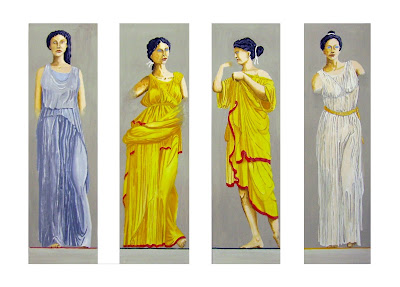
At the moment I have a large body of work assembled of the "Sea Pictures" so there is not so much pressure to produce new work in that direction. This leaves me free to concentrate on my Hellenic project(s) which hark back to the times I spend in Cyprus.
Not surprisingly the mythological material coupled with the modern Cypriot Art scene has exerted something of an influence here. Many years ago when I was in my late teens/early twenties I avidly read the Greek classics. My trips to Cyprus have re-awakened this interest. I have done a lot of random drawings of Hellenic style figures, mainly female, but there has been no real cohesive plan. It was rather like looking around a new environment and just taking everything at face value.
But now, I seem to be on a roll. My plan is to produce around fifteen pieces making up triptychs and polyptychs. The first is a look at the Orestian Trilogy which deals with the murder of king Agamemnon after his triumphant return from the Trojan War; his daughter, Elektra's grief and growing hatred for her mother, Klytemnestra who killed her father Agamemnon and finally the return of her brother Orestes who avenged the killing by an act of matricide.
Not quite your gentle family story.
Shown here is a preliminary drawing of Orestes. This drawing is 24" tall. The plan is to make paintings six feet tall. But a happy accident in making this drawing is making me reconsider. Perhaps these should be works on paper? Finished mixed media drawings rather than paintings? Such is the journey of discovery we call Art. We have an idea, then a plan, then have a rethink. So which way shall this project go I wonder?
As well as the Agamemnon/Elektra/Orestes trilogy, I think another triptych is called for of the protaginists for want of a better word, Klytemnestra/Aegisthos/Kassandra. These would, ideally be shown on a wall opposite the first three. I would like to do three goddesses as another triptych, namely; Artemis/Athene/Aphrodite. Also a four part polyptych featuring the female figures, - caryatids, - of the Erektheion at the Acropolis in Athens.
All these works are intended to be six feet tall.
.jpg)


.jpg)

.jpg) To further illustrate the development of this work here is the line drawing, built up from original sketchbooks.
To further illustrate the development of this work here is the line drawing, built up from original sketchbooks..jpg)

